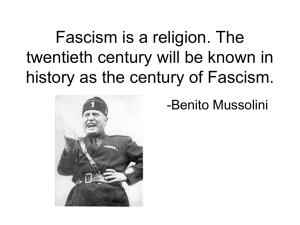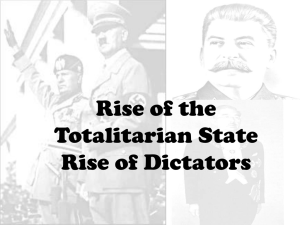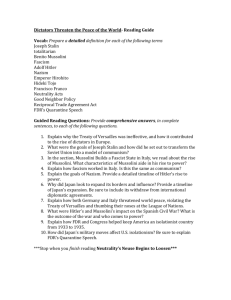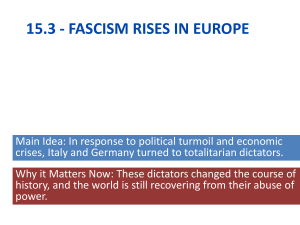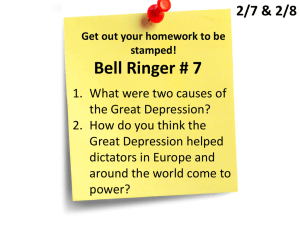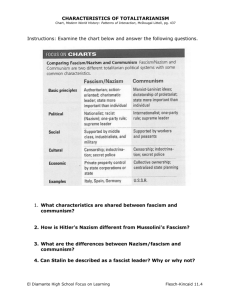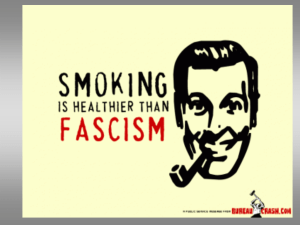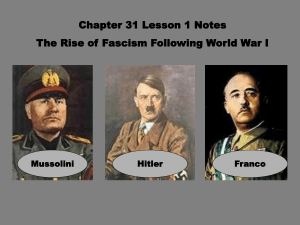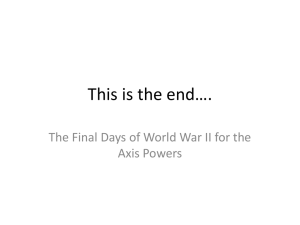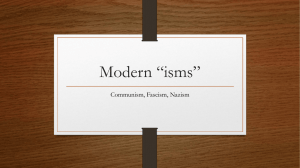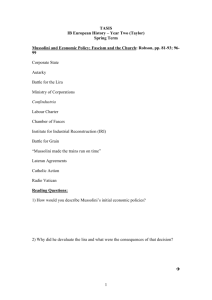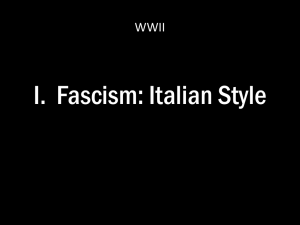Fascism - Mr. McClung's 30
advertisement
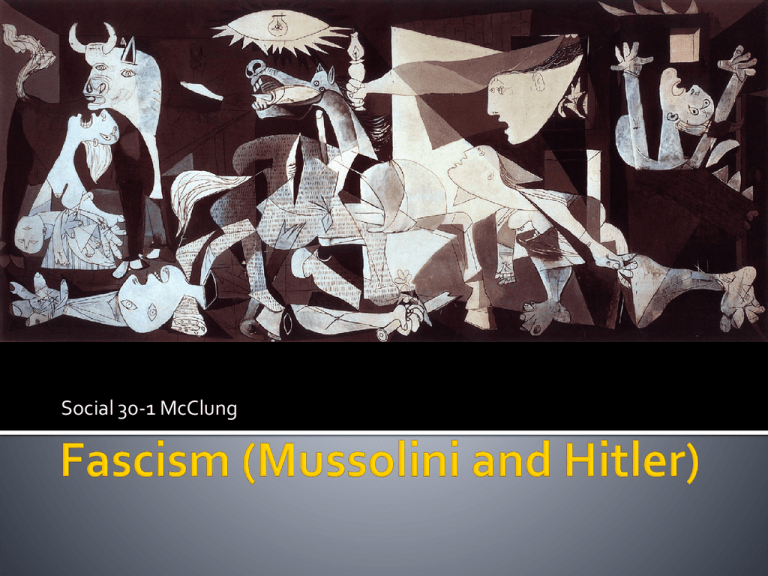
Social 30-1 McClung The word “fascism” comes from the latin word fasces. The fasces was a bundle of rods with and axe that was a symbol in ancient Rome of authority. The fasces later became the symbol for fascism. Nations with one party in control (prevalent in Europe and Asia prior to WWII) -Used idea of Nationalism and Revenge to gain support -Promised the promotion of their country at the expense of “lesser” peoples (Germany-Jews, Japanese-Chinese) -The greater the crisis, the greater the demand for leadership -Provided scapegoats for the problems of their country -Party control of everything + Dictator = False propaganda to gain support -Crushed all opposition -Imperialism to increase strength and increase pride in their country – leads to other conflicts -Generally a very militaristic government and society Mussolini was deeply involved with the Socialist Party prior to WWI. Broke ties with socialists because of their opposition to war. With other ex-socialists, he formed a radical group intent on solving the countries problems. Benito Mussolini Biography The Blackshirts were a voluntary militia group that had the goal of violently promoting nationalism. They fought with socialists in the streets. By the early twenties they controlled many towns. On September 20, 1922, Mussolini called on the Italian king to allow his fascist party to govern Italy. The King refused. Mussolini mobilized his action squads and marched on Rome. Unwilling to risk confrontation, the government resigned. The king called on Mussolini to become Prime Minister and form a new Government. King Emanuelle III Italian Fascist leader Benito Mussolini, center, hands on hips, with members of the fascist Party, in Rome, Italy, Oct. 28, 1922, following their March on Rome. This march was an act of intimidation, where thousands of fascist blackshirts occupied strategic positions throughout much of Italy. Before WWI he had already become acquainted with anti-Semitic and racial ideas. Following WWI, Hitler became involved in a small nationalist group called the German Workers Party. Hitler impressed the members with his speaking ability and soon was put into place as propaganda chairman. Clip 1923 - Hitler attempted to take control of a struggling Germany through the “Beer Hall Putsch.” He failed and was arrested. In jail he wrote “Mein Kampf” exposing his political ideology. He was considered harmless and was released in 1924. 1932 – The Nazi Party won 230 seats during elections, but it was not enough to take control. The government formed a right wing coalition government. Hitler was given the position of the Chancellor of Germany. Once in power he holds a new set of election that give his party alone the ruling power. A fire starts in the Reichstag, Hitler blamed it on the communists. He declares a state of emergency and suspends all civil liberties. 1934 - Hitler declares himself the “Fuhrer of Germany taking dictatorial power. Clip 1, 2 What does the information from the chart suggest about German politics from 1928 to 1933? Use the economic chart and the political chart to determine a cause and effect relationship between the rise of the National Socialists and the state of the German economy. Human Inequality Cult of the Leader Government by Elite Extreme Nationalism Racial Purity and Superiority Organized Violence War and Military Force Almost always are governed by an elite group of friends, family & associates who appoint each other to gov’t positions and use gov’t power and authority to protect their friends from accountability. The term totalitarian was coined (invented) in the early 1920s by Italian dictator Benito Mussolini. It is an extreme form of authoritarian government from either side of the political spectrum [communism and fascism] that exercises absolute and centralized control over its citizens using violence and intimidation: "A totalitarian regime crushes all institutions in its drive to seize the human soul"Arthur M.Schlesinger, Jr. A system of highly centralized government in which one political party or group takes control and grants neither recognition nor tolerance to other political groups. (source: http://www.thefreedictionary.co m) The government is in the hands of a minority who often rule through military might and extreme political repression. (source http://www.ilstu.edu/class/hist12 7/terms.html) Totalitarianism is a form of government in which all societal resources are monopolized by the state in an effort to penetrate and control all aspects of public and private life, through the state's use of propaganda, terror, and technology. (source: http://plaza.ufl.edu/lcur ta/totalitarian.html) Relating to or operating a centralized government system in which a single party without opposition rules over political, economic, social, and cultural life (Source: Encarta) Please read pp. 66 and 67 of Global Systems and pages 167 to 168 in your textbook. If this diagram were a visual representation of the extent of government involvement in a liberal democracy, then using two circles draw what a totalitarian government would look like. Government People autocratic, a definition: a ruler who holds unlimited power and is answerable to no other person Egyptian presidential candidate warns Brotherhood's win will bring back autocratic rule – Cairo April 19, 2011 autocracy, a definition: a one-party government in which somebody holds unlimited power Cairo, Apr 19 : Former Egyptian foreign minister Amr Moussa has warned that if the Muslim Brotherhood's candidate wins the upcoming presidential elections, and if the political wing dominates the parliament, it may yield a one-party system that would bring back autocratic rule. Fascism becomes possible when masses of people feel deeply insecure, and was a response to the ineffectiveness of liberal democracies after World War One. When Mussolini rose to power Italy was beset by serious economic depression combined with inflation and political instability. Fascists rejected many liberal values, such as democracy and individual rights and freedoms. Fascism is anti-communist, anti-liberal, anti-individualist, antirational, anti-parliamentarian, pro-private property (but antilaissez-faire, unregulated capitalism), and anti-egalitarian. The term fascism itself is now used widely to embrace many dictatorial right-wing parties and government across Europe from the 1930s onwards. Fascists emphasized that strong leadership and security in a time of instability and disorder was of prime importance.
